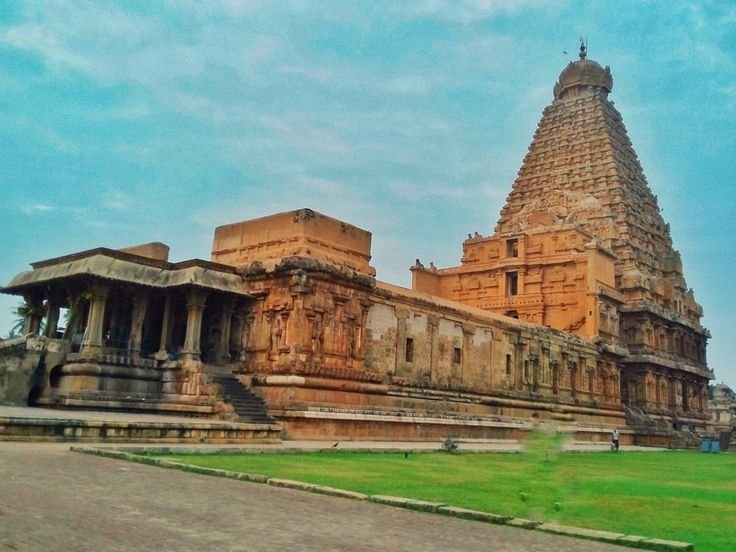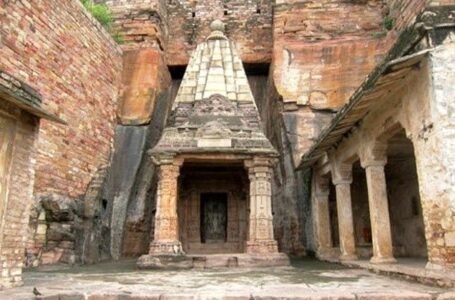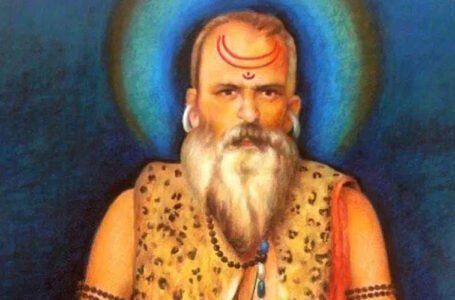Brihadeeswara Temple: The Eternal Marvel of Chola Architecture

The Brihadeeswara Temple, popularly known as Peruvudaiyar Kovil, is undoubtedly one of the most magnificent monuments in the history of Indian architecture. Based in the dusty city of Thanjavur, Tamil Nadu, this majestic temple remains a living testimony of the artistic and engineering genius of the Chola dynasty. The Brihadeeswara Temple is a temple dedicated to Lord Shiva; it is as much an object of devotion as it is a cultural symbol of time.
This temple, during the reign of Rajaraja Chola I in the 11th century CE, would later attain the status of a UNESCO World Heritage Site. It is a wonder of spiritual and architectural importance due to its soaring vimana, intricate carvings, and vastness. Besides its imposing size and structure, the temple is considered to carry with it the symbolic values of the patronage of the Chola dynasty to art, religion, and governance whereby they have made a distinctive mark on South Indian cultural history.
History
The Brihadeeswara Temple was commissioned, around 1010 CE, by Rajaraja Chola I, one of the most illustrious rulers of the Chola dynasty. The golden age of Tamil art, culture, and governance happened during his reign, and this temple stood as the epitome of his power, devotion, and vision while being appeased in stone. The temple was a grand project initiated within seven years, which went beyond the contemporary framework of architecture and engineering.
The temple was initially called Rajarajeshwaram, reflecting the king’s wish that the monument would serve to immortalize the lordship in his divine connection to Lord Shiva and carry his heritage as a king. Each construction detail was planned out very carefully, with contributions from skilled artisans, architects, and labourers working together as one to realize Rajaraja’s vision.
The creation of the temple received financial assistance from Chola’s naval power and a net of trade routes. Completion of this still well-preserved masterpiece was the tangible confirmation of Rajaraja Chola as a great patron of art and religion in history, establishing Thanjavur as a seat of cultural and spiritual relevance. Patronage over the years continued with various rules such as the Nayaks and Marathas, who built on and repaired the temple.
Architectural Brilliance
Breath-taking, the finest example in Dravidian architecture, an exquisite combination of artistically creative and technically ingenious forms, is the majestic Brihadeeswara Temple. What draws attention to this temple tower is its height, in which the vimana rises to 216 feet and is one of the tallest temple towers in the world. A granite stone weighing about 80 tons caps the vimana. The mystery of how that stone was carried up remains with marbles of that size.
The temple complex is made entirely of granite, a material that is not found in the region. This indicates the considerable labour involved in hauling it and working the granite into shape. The size of the temple amazes, from the vast courtyards to intricately ornamented walls and monumental gopurams too, reflecting the power of the Chola empire.
Inside the sanctum stands the Shiva lingam, one of the huge images signifying the cosmic energy of Lord Shiva. Frescoes adorning the walls and corridors depict wealth in different forms, ranging from intricate carvings of Gods and Goddesses or mythological episodes to those from Tamil literature. These carvings not only provide a glimpse of artistic splendour during the Chola period but also represent a valuable reconstruction of the customs prevailing in the country during that time.
Another notable aspect of the temple is Nandi Mandapam, where a grand statue of Nandi stands- it is the mount of Lord Shiva and the sacred bull. Nandi is carved entirely out of a huge granite block; itself, an architectural wonder, stands as a symbol of devotion and strength.
Mythology and Religious Significance
The Brihadeeswara Temple possesses high spiritual standing among devotees of Lord Shiva. Local legends insist that the said temple was created in strict accordance with the divine wish and direction of none other than Lord Shiva himself, who appeared in Rajaraja Chola’s dreams and blessed him with the vision of paving the circumference of the temple. A belief persists that this divine touch has bestowed spiritual power upon the temple, causing it to bloom as a holy centre for worship and meditation.
Brihadeeswara, the temple’s presiding deity, assumes that aspect of Lord Shiva captions “the great Lord of the Universe”. It is said that the Shiva lingam in the sanctum symbolizes the endlessness of the cosmos, which devotees perceive as appealing in regards to goal – liberation and enlightenment.
Many other mythical episodes linked with the temple include the cosmic dance of Lord Shiva in the form of Nataraja, which is carved in the ornamentation on the walls of the temple. These fables are the very basis of religious ritual and festival observances in the temple, thereby giving it a deeper thrust of meaning as far as spiritual relevance and cultural significance are concerned.
Festivals and Rituals
The Brihadeeswara Temple is a centre of active religious activities and rituals attracting thousands of devotees from all over the country. One of the major festivals is Maha Shivaratri, which is celebrated in honour of Lord Shiva. Devotees gather to keep vigil at night, offer prayers, and participate in a cultural program honouring Lord Shiva and his place in the cosmos.
Equally, with good ongoing events of ritualistic significance, such as the yearly Kumbabishekam-a ceremony entailing the consecration of the temple’s inner sanctum-testify to the temple’s continuous spiritual standing. Pouring of sanctified water upon the temple’s tower is believed to call forth renewal, increase the life force of the temple, and grant it some divine protection.
The priests enter into elaborate processes associated with the Agamic traditions during the daily worship at the temple. With offerings of flowers, fruits, and incense, with accompanying Vedic chanting and ringing the temple bells, these drumming patterns of rituals create an atmosphere of divine calmness, allowing devotees to commune directly with the divine energy of Lord Shiva.
Cultural Impact and Legacy
The Brihadeeswara Temple is an ecclesiastical gem and a cultural beacon that has inspired art, architecture, and culture in India and elsewhere. This temple, considered to be a magnificent piece of Chola architecture, has inspired generations of architects, artists, and historians, who look at it with great admiration because of its creativity and beauty.
The temple holds a treasure trove of inscriptions which, by their nature, provide fills-in on donations, rituals, and historical events. These impressions provide indexes into the social, economic, and religious lives of the people, revealing the greater development of administration and culture attained by the Chola dynasty.
For its basic historical and other material contribution, it performed a central role in Tamil culture and now in modern Tamil Nadu. The time-honoured festivals and rituals observed along with the artistic customs that go on in the temple serve as a vigilance for the community in keeping the legacy of Chola flourished inside.
Preservation and Modern Relevance
The Brihadeeswara Temple is, indeed, a monument that has witnessed the ravages of time, menacing storms, and historical upheavals over the centuries. But it is still an impressive structure; successive generations of rulers, historians, and restorationists have always regarded the temple as sacred, allowing succeeding generations to behold its splendour and grandeur.
Today, the temple is a major tourist attraction, drawing visitors from around the world, who come to see its beauty of architecture and the pious atmosphere in and around it. It connects past and present, maintaining a glimpse into the unmatched cultural and spiritual achievements of ancient India.
In the case of the temple, various steps have been taken for its preservation in the context of modern technology and traditional methods to protect its structural integrity and the gaudy carvings from environmental degradation. These initiatives can be very helpful in instilling awe and reverence in posterity.
Conclusion
Beneath the shadow of the Brihadeeswara may lie experiences beyond all classification. Among these ones perceives, that the temple is extraordinarily driven from a monument of switching a living symbol of devotion towards a masterpiece of art and culture. Its high spires, exquisite carvings, and the way that holy people carry out pooja are in sheer obviousness of that flowing moment of the Chola dynasty and of everlasting faith.
One of India’s greatest architectural wonders, the temple still derives admiration over time, recognizing the richness of the culture and the spirituality of India. The Brihadeeswara Temple is an ageless treasure trove for generations yearning for beauty, wisdom, and communion with the divine.
In paying homage to the Brihadeeswara Temple, we pay homage to not just a glorious monument but also one where the indomitable spirit of a civilization devoutly upholds creativity, devotion, and harmony with the cosmos. It stands as India’s proud legacy, urging us to plunge into the mystique of our history and spirituality.


